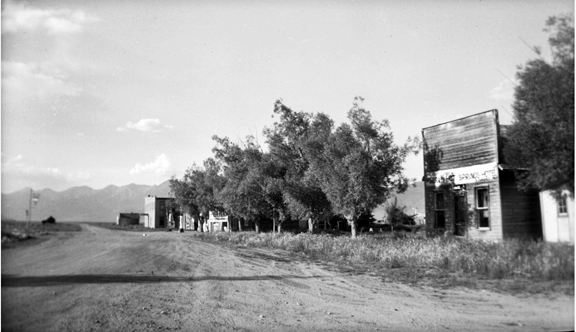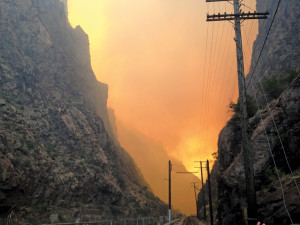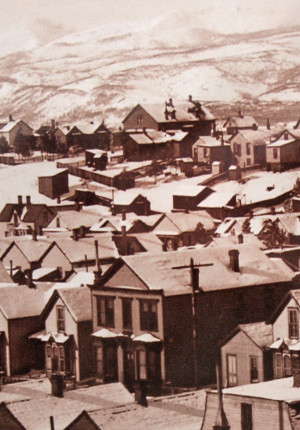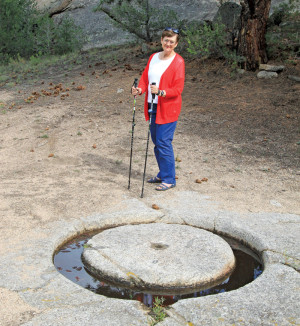By Christopher Kolomitz
Easing the car off the highway and into the dirt parking lot at Joyful Journey Hot Springs, visitors gaze east out across the landscape which is nearly free of obstruction.
Few trees, even fewer buildings and a steadily blowing breeze greet them as they hustle into the warmth of the now modern and popular hot springs facility just south of Villa Grove in Saguache County.
It’s hard to imagine that more than 100 years ago, a city once formed here with great hopes of becoming a tourist destination and prosperous site. However, the brutal climate, the Great Depression, a floundering agriculture economy with poor soil, and life’s hardships ended that hope.
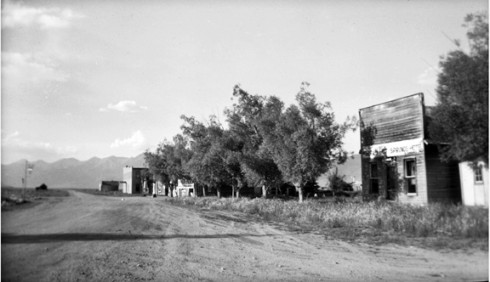
The current location bears little resemblance to its former glory. Gone are the railroad sidings, trees, post office, baseball diamond, swimming pools, café, filling station and ranch homes. That’s all been replaced with a modern hot springs facility complete with a hotel, yurts, sauna, greenhouse and glorious views as guests soak themselves in the mineral-laced waters.
Most locals and maps call the place Mineral Hot Springs, but before 1880 it was called Chamberlin Hot Springs or San Luis Hot Springs and was frequented by miners, cowboys and Indians. The natives knew for centuries of the healing waters that naturally seep from the Earth and like many regional hot springs, they were likely there long before any white man.
In 1892, the Mineral Hot Springs & Land Co., under the direction of George Adams, started to market the hot springs as a destination resort, and improvements were made. Adams hoped the railroads would bring guests to soak, but that never really materialized.
However, in 1911, roughly 237 acres were platted by the Hot Springs Development Co. to become the City of Hot Springs, consisting of approximately 56 blocks. Robert G. Dunshee was president of the development company, and his son Truman was secretary. Soon after being platted, a post office opened and the swimming pool was covered.
The Dunshees had arrived in Moffat around 1909, when the U.S. Census listed Robert’s occupation as a stockman. Earlier, in 1883, he participated in the land rush and staked a claim near Braman, Oklahoma. By 1899, he had made his homestead patent. After the land patent, he left the Oklahoma prairie for the Colorado high country.
Robert Dunshee died in August of 1932 at the Salida hospital at the age of 72 after complications of gallbladder surgery; he was buried in Salida and appeared to live a life dedicated to the advancement of Hot Springs City and the northern San Luis Valley.
Dunshee most likely knew of the potential a hot springs resort could bring to the area, which was already teeming with railroad service, ranching and mining. Hundreds were working at the Orient Mine, 14 ranches dotted the hills between the springs and Moffat, and there were at least two physicians.
Dunshee set out to create the town, promote the area and make a little money at a time when other hot springs like Mt. Princeton and Glenwood were booming. He constructed the Hot Springs Hotel and his wife ran the place and cooked. He served as postmaster from 1911 to 1922 in an area that was booming. In 1911, Moffat included two newspapers, five real estate offices, a fine mercantile and numerous other commercial businesses.
By 1915, according to a note in the Del Norte San Juan Prospector newspaper, the state public utilities commission summoned railroad officials to explain why they were not building a station at Mineral Hot Springs. A few weeks later, the paper reported that it was looking favorable to have a station and agent at Mineral Hot Springs after a member of the Saguache Commercial Club had traveled to Denver to present to the commission the case for a station. According to records at the Colorado Railroad History Museum, the station didn’t arrive until sometime between July 1920 and December 1921.
Also in 1915, Truman Dunshee left the area to take a teaching position in Mancos. Truman later went on to serve in World War I; he made it back alive and settled in California. Additionally, the Dunshee father-son team worked to form the San Luis Valley Irrigation District in early 1915, with their interests confined to the Kerber Creek area.
By 1920, Robert Dunshee was listed in the U.S. Census as manager of the Hot Springs Resort at Mineral Hot Springs and the area was off on its boom cycle, with Dunshee constructing a swimming pool, dance hall, cabins, roller skate rink and five-room hotel at the resort.
The historical archives of The Saguache Crescent include many notes about the residents of Mineral Hot Springs, their travels and guests. People were going to the D&RG hospital in Salida, hosting parties, taking trips and receiving friends from all over the country.
The Wet Mountain Tribune from July of 1923 includes a report that in two weeks more than 500,000 pounds of wool valued at $200,000 were loaded at Denver & Rio Grande Western stations including Mineral Hot Springs.
In January of 1924 many state newspapers reported that a young Saguache girl was killed when the car she was riding in with her brother and another girl rolled. The wreck happened as the three were heading to Mineral Hot Springs in a snowstorm.
In the summer of 1925 the little town was in its heyday, and Dunshee was working hard to promote his enterprise with multi-day celebrations held on the weekends. The Saguache Crescent boasted that “Mineral Hot Springs has the best water and cleanest swimming pools in the state.” Advertising for the party weekends noted plenty of shade, good cold water, refreshments and “eats of all kinds.”
Opening day 1925 was the first Sunday of June with ideal weather. Some weekends featured “high class” music for dancing furnished by an orchestra from the college in Gunnison. Throughout the summer, a slate of baseball games were held featuring San Luis Valley and Salida teams.
All sorts of other competitions were held that summer, too, including wrestling, high diving, swimming and running races and dancing contests too. The weekends were also marked with “ciphering” and “intelligence” contests for children. Prizes were $3 for first place and $2 for second.
The San Luis Valley Bus Co. was advertising two trips a day between Alamosa and Salida with stops at Mineral Hot Springs. The minimum fare was 25 cents with 5 cents per mile between stations.
In the July 30 edition of The Saguache Crescent, the paper reported more than 1,200 people at the resort for the “American Legion Frolic.” It was reported to be the largest crowd ever at the resort. The final sentence mentions that the Legion was grateful to Mr. Dunshee for turning the resort over to them.
In August, the Modern Woodmen and their families were guests at the resort. There was a big, free barbeque put on by Mr. Dunshee that attracted hundreds, a double-header baseball game between Salida and Hooper and more dancing.
In the Sept. 27 edition The Saguache Crescent reported that the following Sunday was watermelon day and that R. Dunshee, the manager of the swimming pool and dance hall, would give away free watermelons.
Special children swimming rates were in place and anyone that had their own swimsuit could swim for 10 cents. A $2 prize would be given to a boy or girl who could give the best answer to three questions. Dancing would be held throughout the evening with music by Hayden Simpson’s orchestra. A special invitation was made for all to attend.
Later in the fall of 1925, Dunshee went on a bear hunt but came up empty. In December, he and his wife attended a radio party followed by an oyster supper in Saguache.
In 1927, Dunshee was showing off some of his antiphlogistine clay, which was a mix that supposedly had healing properties and was used for all sorts of remedies, from sunburns to body aches.
The Nov. 18, 1927 edition of the Eagle Valley Enterprise reported that “the state geologist has pronounced the deposit as real antiphlogistine clay and Mr. Dunshee finds it has the same effect as the preparations on sale in the drug stores. He has also made up some beauty clay which is common use. The mine runs fifteen feet in depth and extends about one-third of an acre.” It’s easy to assume that Dunshee was mining the clay from the hot springs source and peddling it.
By 1930, Dunshee was out at Mineral Hot Springs and was living at his homestead on Cotton Creek. He had sold a portion of the operation to Ada Collins, who supervised everything except the swimming pool, which was managed by Harold and Marjorie McCullum. Collins also ran a store in the town and was postmaster from 1926-38. After Collins, the postmaster was Mrs. Aron Seip, who held the position until the post office was closed in 1946.
In February of 1931, there was a newspaper note about three carloads of young people from Del Norte and Saguache gathering at the pool. The lobby and dressing rooms were cold because the pool manager had loaned the heating stoves to his neighbors. In April 9, 1931, 20 friends gathered at the Dunshee residence to celebrate Robert’s 71st birthday. He died a year later.
By summer of 1943 the number of notes appearing in The Saguache Crescent about Mineral Hot Springs was down to seven, including several mentions of families leaving the town. In its heyday, upwards of 25 notes were published regarding the residents of Mineral Hot Springs and their doings. Although by 1943 the town was losing its steam, the Saguache High School junior-senior picnic was still held there in early May. By this time, a fellow by the name of Elmer Walker had taken over all operations at the site, including the swimming pool, hotel, cabins and store.
Passenger service ended around 1949 and the railroad became all freight. The line over Poncha Pass closed in 1951 and from there, the history of Mineral Hot Springs becomes cloudy with multiple owners, a gasoline station, café, lawsuits, pigs and hippies. We will be exploring the modern history of this fascinating piece of San Luis Valley and Colorado history in next month’s Colorado Central.
Christopher Kolomitz is a freelance journalist and small business owner living in Salida. He likes to go to Hot Springs City after long ski days and to think of times slower and simpler.
